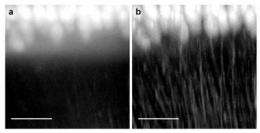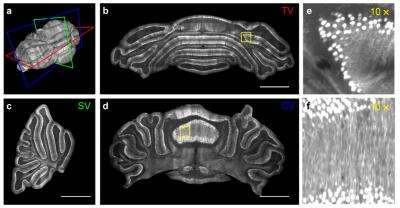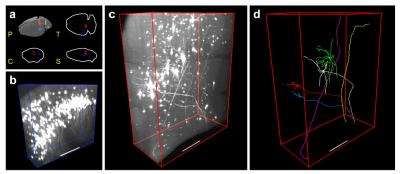Novel microscopy method offers sharper view of brain's neural network

Shortly after the Hubble Space Telescope went into orbit in 1990 it was discovered that the craft had blurred vision. Fortunately, Space Shuttle astronauts were able to remedy the problem a few years later with supplemental optics. Now, a team of Italian researchers has performed a similar sight-correcting feat for a microscope imaging technique designed to explore a universe seemingly as vast as Hubble's but at the opposite end of the size spectrum—the neural pathways of the brain.
"Our system combines the best feature of one microscopy technique—high-speed, single-plane imaging of multiple sections of a sample—with a second method that eliminates the accompanying problem of scattered background light leading to blurriness," says Francesco Pavone, leader of a collaborative team from six Italian research agencies and one of the authors of a paper describing the advance that is published today in the Optical Society's (OSA) open-access journal Optics Express.
Light-sheet based microscopy (LSM), also known as single plane illumination microscopy (SPIM), is a state-of-the-art microscope imaging method in which a biological sample is illuminated with a thin sheet of light—provided by a laser beam narrowed to just a few microns, or millionths of a meter, across—coming from the side rather than from above or below as with traditional light sources. Fluorescence bouncing off the illuminated sample radiates upward through a lens, gets focused and is captured by a digital camera.
Because the light sheet illuminates the part of the sample directly in the same plane, only a single section of the target is imaged at a time. Raising and lowering the illumination plane, as well as rotating the sample, rapidly produces a series of two-dimensional sectional views known as "slices" that can yield a 3-D map of a whole organism or any of its organs/systems when the individual 2-D visual pieces are brought together.

One region that scientists have tried to survey in mice with LSM is the neural pathway, the billion-fold network of neurons that underlie the functioning of the brain. While the LSM method yields high-resolution views of tissue excised from mouse brains and fixed in position, whole brain samples scatter the emitted light and create background fluorescence that reduces contrast and blurs the perceived image. Obviously, this aberration makes it impossible to resolve and reconstruct the entire neuronal network with a high contrast.
To correct the problem, Pavone and his colleagues combined the advantages of light sheet illumination with confocal microscopy, an imaging method that uses a filter to remove photons that stray from the single plane of the thin sheet.

"We found that the combined system, which we call confocal light sheet microscopy or CLSM, filtered the scattered photons that were emitted and recovered the normally lost image contrast in real time without the need for multiple acquisitions or any post-processing of the acquired data," Pavone says. "This allows us to obtain sharp image slices that can be easily reconstructed into a macroscopic view of whole organs or entire organisms with a resolution of a few microns and faster acquisition time."
The images obtained with CLSM, Pavone says, are 100 percent sharper than those acquired with conventional LSM.
The researchers validated the background rejection capabilities of CLSM by showing that it results in significantly sharper images than conventional LSM microscopy and than a variation of LSM that requires redundant slices and post-processing to remove scattered light. CLSM proved superior to the other two methods when used to view three samples from mouse brains: the hippocampus, the cerebellum and the whole brain. The 3-D reconstruction ability of CLSM also was put to the test when the researchers used it to map the micron-scale neuroanatomy of mouse Purkinje cells (large neurons found in the cerebellum) and trace an entire brain's neuronal projections (the finger-like ends of a neuron by which neurochemical signals are received from other nerves).
According to Ludovico Silvestri, another member of the research team, this was the first time that a fluorescent mouse brain has been imaged in its entirety with such clarity. He adds that, in principle, the technique should be applicable to human brain samples if the current obstacle of fluorescently staining large blocks of fixed tissue can be overcome.
"The high-contrast fluorescence and fast acquisition assured by CLSM may represent a powerful tool to help neuroscientists navigate through the neuronal pathways of the brain," Pavone says. "Although this study was focused on brain imaging, we believe that CLSM also is ideally suited to explore—at micron-scale resolution—the anatomy of different specimens such as murine organs, embryos and flies."
Along with refining CLSM to improve its imaging capabilities, Silvestri says the research team is using CLSM to image mouse models of several diseases, including autism and ischemic stroke. "We hope that the whole-brain tomographies we can obtain will one day provide insights into the mechanisms of these and other brain disorders," he says.
More information: Optics Express, Vol. 20, Issue 18, pp. 20582-20598 (2012). doi: 10.1364/OE.20.020582
















